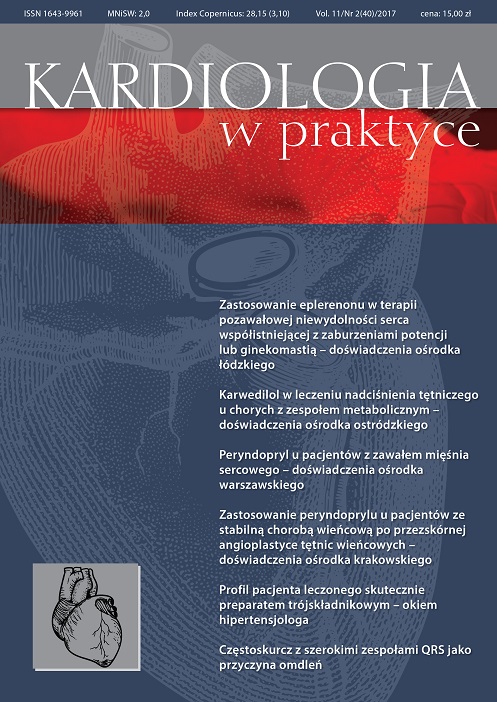Carvedilol in the treatment of hypertension in patients with metabolic syndrome – experience of Ostróda center Case report
Main Article Content
Abstract
Metabolic syndrome is associated with a very high risk of developing atherosclerosis and type 2 diabetes and their vascular complications. In this patient population, the choice of antihypertensive therapy with the most favorable metabolic profile is particularly important. This paper presents a clinical case illustrating the possibility of hypertension treatment in a patient with metabolic syndrome and cardiac arrhythmia.
Downloads
Article Details

This work is licensed under a Creative Commons Attribution-NonCommercial 4.0 International License.
Copyright: © Medical Education sp. z o.o. This is an Open Access article distributed under the terms of the Attribution-NonCommercial 4.0 International (CC BY-NC 4.0). License (https://creativecommons.org/licenses/by-nc/4.0/), allowing third parties to copy and redistribute the material in any medium or format and to remix, transform, and build upon the material, provided the original work is properly cited and states its license.
Address reprint requests to: Medical Education, Marcin Kuźma (marcin.kuzma@mededu.pl)
References
2. Alberti K.G., Zimmet P., Shaw J.; IDF Epidemiology Task Force Consensus Group: The metabolic syndrome – a new worldwide definition. Lancet 2005; 366: 1059-1062.
3. Zdrojewski T., Bandosz P., Szpakowski P. et al.: Rozpowszechnienie głównych czynników ryzyka chorób układu sercowo-naczyniowego w Polsce. Wyniki badania NATPOL PLUS. Kardiol. Pol. 2004; 61(supl. IV): IV1-IV26.
4. Leoncini G., Ratto E., Viazzi F. et al.: Metabolic syndrome is associated with early signs of organ damage in nondiabetic, hypertensive patients. J. Intern. Med. 2005; 257: 454-460.
5. Mule G., Nardi E., Cottone S. et al.: Influence of metabolic syndrome on hypertension-related target organ damage. J. Intern. Med. 2005; 257: 503-513.
6. Tykarski A., Narkiewicz K., Gaciong Z. et al.: Zasady postępowania w nadciśnieniu tętniczym – 2015 rok. Wytyczne Polskiego Towarzystwa Nadciśnienia Tętniczego. Nadciśn. Tętn. Prakt. 2015; 1: 1-70.
7. Deedwania P.C.: Diabetes and hypertension, the deadly duet: importance, therapeutic strategy and selection of drug therapy. Cardiol. Clin. 2005; 23: 139-152.
8. Filipiak K.J., Tykarski A., Czarnecka D. et al.: Miejsce wazodylatacyjnych leków beta-adrenolitycznych w terapii nadciśnienia tętniczego i jego powikłań sercowo-naczyniowych. Stanowisko ekspertów. Nadciśn. Tętn. 2010; 6: 421-433.
9. Bell D.S.: Selection of antihypertensive therapy in the patient with diabetes. Online: www.medscape.com/viewprogram/3599_pnt.
10. Bank A.J., Kelly A.S., Thelen A.M. et al.: Effects of carvedilol versus metoprolol on endothelial function and oxidative stress in patients with type 2 diabetes mellitus. Am. J. Hypertens. 2007; 20: 777-783.
11. Giugliano D., Acampora R., Marfella R. et al.: Metabolic and cardiovascular effects of carvedilol and atenolol in non-insulin-dependent diabetes mellitus and hypertension: a randomized, controlled trial. Ann. Intern. Med. 1997; 126: 955-959.
12. Bakris G.L., Fonseca V., Katholi R.E. et al.: Metabolic effects of carvedilol versus metoprolol in patients with type 2 diabetes mellitus and hypertension: randomized controlled trial. JAMA 2004; 292: 2227-2236.

